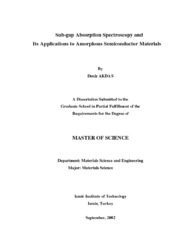Please use this identifier to cite or link to this item:
https://hdl.handle.net/11147/3272| Title: | Sub-Gap Absorption Spectroscopy and Its Applications To Amorphous Semiconductor Materials | Authors: | Akdaş, Deniz | Advisors: | Güneş, Mehmet | Publisher: | Izmir Institute of Technology | Abstract: | Subgap absorption spectroscopy is one of the most fundamental experimental tools to investigate absorption coefficient, a(hn), spectrum in amorphous semiconductors. The effects of the disorder and defect states can be observed in the a(hn) spectrum. For this goal, dual beam photoconductivity technique (DBP) has been established and applied to the hydrogenated amorphous silicon, (a-Si:H), thin films prepared by different deposition systems, both in the annealed and light soaked states. In the annealed state, the effects of the native defect states in a-Si:H films were studied using dark conductivity, steady state photoconductivity and the DBP technique. The samples showed different dark and photoconductivity values. The a(hn) spectrum obtained from the DBP measured at different bias light intensities shows three regions. At high energies, parabolic extended state absorption dominates. As energy decreases below the bandgap, the exponential valence band tail absorption appears. At energies below 1.4 eV, the subgap absorption due to the midgap defect states exhibits a shoulder in the spectrum. Absorption coefficient at a (1.2 eV) showed variation among the films. Photoconductivity and subgap absorption values could not be correlated directly. This implies that more than one type of native defects is present in a-Si:H. In the light soaked state, samples were left under a white light source of a few sun intensity. All the samples showed the Staebler-Wronski effect. However, the magnitude of degradation in photoconductivity is different for all the samples and is not directly proportional to the increased subgap absorption. It is inferred that both measurements are not controlled by the same defect states. As a summary, the DBP technique established in this thesis was found to be a reliable characterization tool to study amorphous and microcrystalline silicon films. The DBP results with those of photothermal deflection spectroscopy (PDS) and constant photocurrent method (CPM) techniques showed very good agr eement, implying that DBP is a reliable spectroscopic tool for future investigations. | Description: | Thesis (Master)--Izmir Institute of Technology, Materials Science and Engineering, Izmir, 2002 Includes bibliographical references (leaves: 98-102) Text in English; Abstract: Turkish and English x, 102 leaves |
URI: | http://hdl.handle.net/11147/3272 |
| Appears in Collections: | Master Degree / Yüksek Lisans Tezleri |
Files in This Item:
| File | Description | Size | Format | |
|---|---|---|---|---|
| T000127.pdf | MasterThesis | 1.45 MB | Adobe PDF |  View/Open |
CORE Recommender
Page view(s)
102
checked on Dec 23, 2024
Download(s)
42
checked on Dec 23, 2024
Google ScholarTM
Check
Items in GCRIS Repository are protected by copyright, with all rights reserved, unless otherwise indicated.